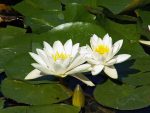 Also known as European white water lily, white water rose, or white nenuphar, this aquatic flowering plant is native to North Africa, temperate and tropical Asia, and Europe where it grows in marshes, ponds, slow moving stream and lakes. It is a member of the water lily family, Nymphaeaceaea, a small family that includes 3-6 genera. Plants grow in water that is 12-59″ deep and produce rounded green leaves that are up to 12″ in diameter and float on the surface of the water. The slightly fragrant flowers are up to 8″ across, have 12- 28 white petals with many small golden stamens, and are cup-shaped at first but become star-shaped with age. White water lily is a big plant and needs a big area in which to grow. Plants bloom all summer during the day adding both fragrance and beauty so a a good choice for a water garden if plenty of room is avaiable. The genus name, Nymphacea, comes from the Greek word numphaios and means sacred to the nymphs. The specific epithet, alba, is the Latin word meaning white, and refers to the color of the flowers.
Also known as European white water lily, white water rose, or white nenuphar, this aquatic flowering plant is native to North Africa, temperate and tropical Asia, and Europe where it grows in marshes, ponds, slow moving stream and lakes. It is a member of the water lily family, Nymphaeaceaea, a small family that includes 3-6 genera. Plants grow in water that is 12-59″ deep and produce rounded green leaves that are up to 12″ in diameter and float on the surface of the water. The slightly fragrant flowers are up to 8″ across, have 12- 28 white petals with many small golden stamens, and are cup-shaped at first but become star-shaped with age. White water lily is a big plant and needs a big area in which to grow. Plants bloom all summer during the day adding both fragrance and beauty so a a good choice for a water garden if plenty of room is avaiable. The genus name, Nymphacea, comes from the Greek word numphaios and means sacred to the nymphs. The specific epithet, alba, is the Latin word meaning white, and refers to the color of the flowers.
Type: Flowering aquatic perennial
Bloom: Slightly fragrant flowers up to 8″ across with 12-20 white petals and many small golden stamens; cup-shaped at first, star -shaped with age, in summer
Size: 3-5′ wide
Light: Full sun
Soil: Fertile loam in undisturbed water
Hardiness: Zones 4-11
Care: Deadhead and remove yellow leaves as they appear; feed regularly with fertilizer for aquatic plants.
Pests and Diseases: Brown China mark-moth, brown spot, crown rot, false leaf-miner midge, water lily aphid, water lily leaf spot, water lily beetle
Propagation: Division of rhizomes or offsets in summer
Companion Plants: Water hyacinth, water lettuce, cattail
Photo Credit: Wikimedia